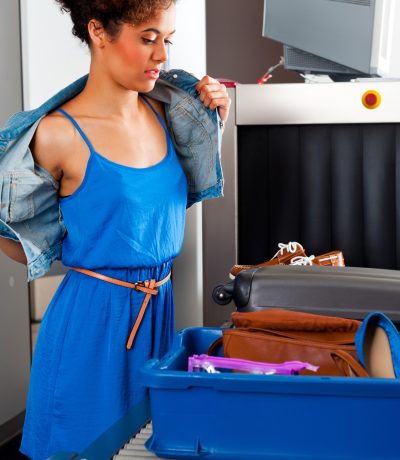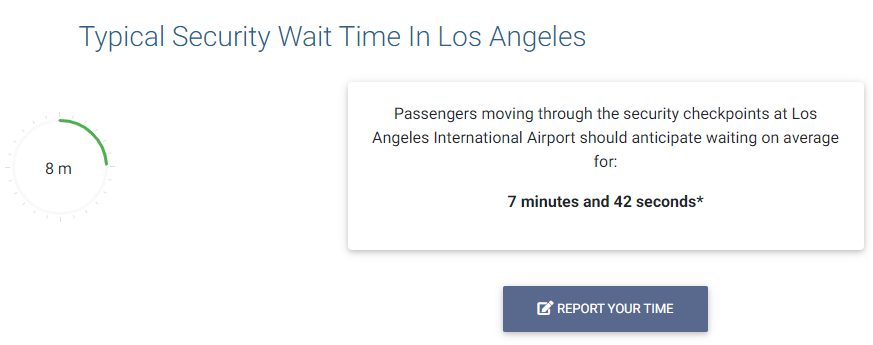9 Airport and Security Hacks for Every Traveler
13 April 2023
T.S. Eliot had a unique perspective on travel: “The journey not the arrival matters.” Of course, Eliot didn’t have to navigate the TSA, customs agents, and all the modern tediums that we do now.
I’m sure we can all agree that one of the most tedious parts of traveling is dealing with the airport and security.
In addition to knowing what you can and can’t bring through security, having a known traveler number (via TSA PreCheck or Global Entry), and organizing your liquids like a pro, the following tips and hacks can help you speed through the airport and security checkpoints.

1. Download these apps
You probably have these already, but just in case you forgot, download these apps:
- Your airline’s app – and check to make sure your flight and boarding passes are available
- The TSA app – for checking how busy the airport is on your travel day plus weather conditions and delay info
A few hours before your flight, you can check the TSA wait times on the MyTSA app or tsawaitimes.com. Select the airport you’re flying from to see how long it’s taking people to get through security right now.

If the wait is less than 15-20 minutes, you probably don’t have to adjust your intended arrival time. If it’s longer, you may want to start out earlier. It’s better to know before you arrive at the airport.
2. Weigh your bags before you fly
Every airline has its own weight limits for checked bags and carry-ons. Typically, the cheaper the airline, the lower the weight limit for both.
Most airlines won’t weigh your personal bag – a briefcase, purse, or backpack; however, low-budget airlines will sometimes include both bags in the total weight limit you’re allowed.
Pro tip: the airlines won’t weigh you (unless you’re flying on one of the really small planes), so if you need to reduce the weight, wear more things! This is where jackets with pockets come in handy.
3. Dress for chilling out
The golden era of flying, when people dressed up and everyone was treated courteously, is over. The good part of that story is that you no longer have to dress like you’re interviewing for an executive position to fit in.
Dress for a cozy night instead, and this means:
- Comfy layers as temperatures can vary widely at altitude.
- Warm fuzzy socks so you can slip off your shoes and avoid swelling without grossing anyone out.
- A face mask in case anyone is coughing near you – why take the risk?
- Less jewelry because the metal can trigger the body scanner alarm.
Also, have an eye mask, earbuds or headphones, and a light blanket. If you want to sleep or signal that a noisy seatmate should leave you alone, these can all help.
4. Bring longer charging cords
If you need to charge up at the airport, you can’t guarantee how close you’ll be to the plug. If there’s a pileup of delays or cancelletions, you won’t be the only one searching for juice.
Bring longer charging cords than you typically use so you can plug in and step out of the way of others. Even better, tuck a power strip in your bag, and you could be the terminal hero!
Pro tip: if you lost your charging cord (or forgot it) and you have time on your hands, head to the airport lost and found to see if you can snag one left behind by another tired traveler.
5. Print your boarding passes
I know, it sounds outdated, but hear me out. If the Wi-Fi goes down or your phone, for some reason, can’t connect, you won’t be stuck scrambling.
If your phone is in the scanner bucket and the agent asks to see your ticket, that paper copy can be handy.
Personally, I like to have my boarding passes in all the forms – in the app, downloaded to my phone, and printed.
6. Read the signs and the crowds
Even if you’re familiar with the airport, stay observant! Read the signs and the crowds.
Airports get revamped all the time, so things may not be where you expect them to be. This is true even for small regional airports, so carefully reading the posted signs can be helpful.
People don’t always know where they are going, but sometimes they know something you don’t. I remember passing through Denver International once, and I noticed the security lines in the pit were backed up, but a row of travelers were headed to the second floor.
Lo and behold, there was a second, less packed, security line up there!
7. Choose the quickest security line (to the left)
This one’s tricky, but helpful when there are multiple lines. It’s not just about the length of the line but also who’s in it and who’s managing it.
Let’s face it, some TSA agents are quicker than others. The same is true for travelers.
Observe the agents and travelers ahead of you for clues. Families with small children and strollers can take longer to get through security; business travelers can be quicker because they’re experienced. That loud and happy group of slightly drunk bachelors and bachelorettes aren’t paying attention. They’re gonna take some time getting through security.
Follow the travelers that are efficient. They have their ID out, their jacket unzipped, and their shoes are easy to remove.
Pro tip: go to the left! More people are right-handed, and it’s human nature to go toward our dominant side. The left-hand lanes are often less populated.
8. Wear a jacket with lots of pockets
Hear me out on this one because it can make a big difference!
After showing your ID and boarding pass to the agent, some things you do can either slow the line or speed you through. You’re gonna have to take the jacket off even if you have TSA PreCheck, so use the jacket to your advantage:
- Empty your pockets into the jacket’s pockets
- Put all the things you have in your hands into the jacket pockets
- Put your watch, wallet, and phone in the jacket too
- Fold the jacket and place it in the bin
And voila! you’ve secured the items that will cause the machine to beep without having to open up your bags. It’s so much quicker, and safer too because a thief on the other side of security is more likely to grab a backpack than a plain old jacket.
After you get through, put your jacket on and walk away. You can re-arrange things in their proper places after you find your gate.
9. Go to your gate right away
Even if you’ve arrived early, go to your gate right away to be sure you know where it is.
I once nearly missed a flight because I was waiting at coffee shop near a gate that’s number was close to the one I was to fly out of only to find out the gate I needed to be at was 15 minutes away!
Once you’ve confirmed you know where your gate is, and checked the flight monitors to see that it hasn’t changed, you can relax a bit and get a snack.
Related topics
Damian Tysdal is the founder of CoverTrip, and is a licensed agent for travel insurance (MA 1883287). He believes travel insurance should be easier to understand, and started the first travel insurance blog in 2006.
